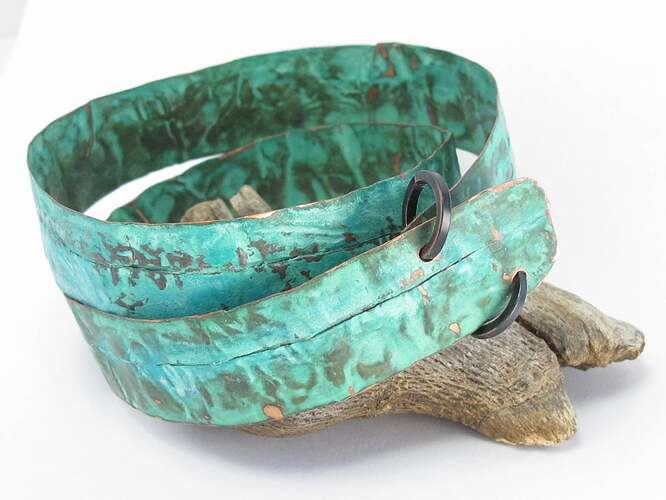Materials: verdigris patina, salvaged copper metal, square copper wire, lacquer, preservation wax
Dimensions: 3 inches diameter
The thin copper sheet metal for this primitive and earthy verdigris bracelet is from the local salvage yard. I cleaned it, hammered it, folded it and added several layers of verdigris patina on both sides. Holding it together are two rings made of square copper wire with a dark brown patina. I see this wraparound bracelet on the woman or man who likes an earthy, primitive look inspired by ancient cultures and tribes like the Celtic and Romans. The bracelet comfortably fits a woman with an averaged-sized hand and wrist. It has to be slipped over the hand since there is no clasp in this design. The diameter is approximately 3 inches, as you can see in photo 5. There are no rough edges, and it is very lightweight to wear. It was finished with two coats of lacquer and three hand-rubbed layers of preservation wax. With normal care, this patina should not wear off on your skin and clothing.
Photo credit: Christi Dick
Christi Hutchins Dick
Lost Marbles Jewelry
Abilene, TX. USA
One day I lost my marbles and all my good sense and moved back to my hometown in West Texas to marry a blue-eyed boy.
Lost Marbles Jewelry started out as a typical jewelry shop -- spending too much money buying beads and making pieces just like everyone else.
Then something snapped inside me when I discovered applying rustic patinas onto copper. Now I'm enjoying the primitive and crusty world of alchemy and the basic elements of life on this planet.
I live with less concrete and pollution and traffic. I can see the stars at night, smell the ammonia of my patina station and bang away with my hammer while feeling a deep connection with the artisans of the Bronze Age.
It's deeply gratifying and feeds a part of my soul that has been dormant for many decades.
Welcome to the crustiness of life.
Christi
The exhibition explores metal works whose primary theme is color embraced as their primary visual focus, whether that be using colored materials, exploring creating colored surfaces, or encasing the object in color.
As the world's largest jewelry related internet site, Ganoksin strives to develop exhibitions showcasing work from around the world. This exhibition was open to all metalsmiths, professional and amateur, advanced and beginner.
In total 303 artists contributed 814 show pieces for the permanent online exhibition.
The exhibition was curated by Beth Wicker, President of the North Carolina Society of Goldsmiths in the United States, and Adjunct Instructor at Northeastern Technical College in South Carolina. Director of the exhibition is Hanuman Aspler, founder of The Ganoksin Project, the world's largest internet jewelry site.
Hue is one of the primary properties of color, it refers to the place the color occupies on the visual spectrum. Humans have used hues throughout time, to create cave paintings, to decorate themselves, their clothing and their housing.
Different hues have taken on different meanings throughout time. Gold traditionally has been a color of purity - the metal gold is relatively unchangeable, and the hue of gold has come to stand for gods and goddesses, for royalty, for durability and for purity. Red has often meant love, or passion. Hues often reflect the meaning of the seasons, with pastels referring to spring and the burst of new life after the pale hues of winter. Summer is reflected in vibrant, deep hues, followed by the browning of hues in the fall as plants go to seed and die, and the land turns fallow.
The worth of a hue has often been tied to what is necessary to make the pigment that creates the hue, and the expensive involved in the process. Often created from crushed stones that had to be mined and carried by caravan over thousands of miles, or from fermented roots of plants only grown in certain areas, or the carapaces of rare insects - the creation of hue in a way that could be used by man was an involved and generally expensive process.
In today's world metalsmiths have access to perhaps the widest range of materials and hues in the history of man - and in some of the most affordable ways ever.
This exhibition celebrates hue - color - as an integral, inherent element of the work. We talk of the "richness" of color, and examples of this abound here. One expects hues from the colors of gemstones used in metalsmithing, but we also have hues from some less expected places. Glass enamels are an ancient way of adding color, as are a variety of patinas. Today's artists also use synthetic man-made materials to add color in ways that didn't exist a century ago.
We invite you to enjoy this celebration of hue, and the ways hues and their use have changed over time.
